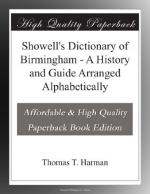Great Western.—The first portion of the Oxford and Birmingham Railway (between here and Banbury) was opened Sept. 30, 1852, the tunnel from Moor Street to Monmouth Street being finished on June 6th previous. The original estimated cost of this line was but L900,000, which was swelled to nearly L3,000,000 by the bitter fight known as the “Battle of the Gauges.” The line from Snow Hill to Wolverhampton was opened Nov. 14, 1854. The first train to Stratford-on-Avon was run on Oct. 9, 1860. The Oxford, Worcester, and Wolverhampton line was opened in May, 1852. The broad gauge was altered in 1874.
Railway Jottings.—The London and Birmingham line cost at the rate of L23,000 per mile, taking nearly five years to make, about 20,000 men being employed, who displaced over 400,000,000 cubic feet of earth. The Grand Junction averaged L16,000 per mile, and at one time there were 11,000 men at work upon it. Slate slabs were originally tried for sleepers on the Birmingham and London line.
The first railway carriages were built very like to coaches, with an outside seat at each end for the guard, though passengers often sat there for the sake of seeing the country.
The fares first charged between Birmingham and London were 30s. by first class, and 20s. second class (open carriages) by day trains; 32s. 6d. first class and 25s. second class, by night. In 1841 the fares were 30s. first, 25s. second, and 20s. 3d. third class; they are now 17s. 4d., 13s. 6d., and 9s. 5d.
“Booking” was a perfectly correct term when the lines were first used, as when passengers went for their tickets they had to give their names and addresses, to be written on the tickets and in the book containing the counterfoils of the tickets.
The day the Grand Junction line was opened was kept as a general holiday between here and Wolverhampton, hundreds of tents and picnic parties being seen along the line.
The directors of the Birmingham and Gloucester line ordered eleven locomotives from Philadelphia at a cost of 85,000 dollars, and it was these engines that brought their trains to Camp Hill at first. In comparison with the engines now in use, these Americans were very small ones. The trains were pulled up the incline at the Lickey by powerful stationary engines.
On the completion of the London line, the engineers who had been employed presented George Stephenson at a dinner held here with a silver tureen and stand worth 130 guineas. This celebrated engineer made his last public appearance at a meeting in this town of the Institute of Mechanical Engineers, July 16, 1848, his death taking place on the 12th of the following month.
The L. & N.W.R. Co. have 46,000 men in their employ.
The G.W.R. has the longest mileage of any railway in England, 2,276-1/2 miles; the L. and N.W.R., 1,774-1/2 miles; the Midland, 1,225 miles.
The returns of the L. and N.W., Midland and G.W.R. Companies for 1878 showed local traffic of 936,000 tons of goods, 693,000 tons of coal, coke and other minerals, 20,200 loads of cattle, and 7,624,000 passengers.




